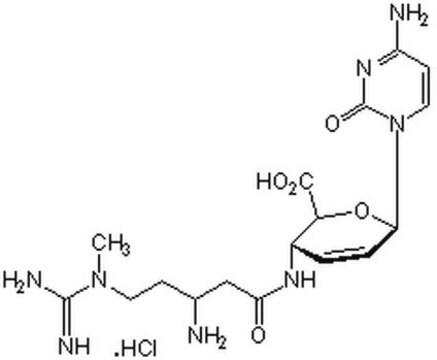10843555001
Roche
Hygromycin B
from Streptomyces hygroscopicus
Synonim(y):
Hygromycin B from Streptomyces hygroscopicus
About This Item
Polecane produkty
pochodzenie biologiczne
Streptomyces hygroscopicus
sterylność
non-sterile; 0.2 μm filtered
Próba
80% (HPLC)
Postać
buffered aqueous solution
skład
Hygromycin B, >80% HPLC
opakowanie
pkg of 20 mL (1 g)
producent / nazwa handlowa
Roche
stężenie
50 mg/mL
metody
transfection: suitable
ciąg SMILES
CN[C@H]1C[C@@H](N)[C@H](O)[C@@H](O[C@@H]2O[C@H](CO)[C@H](O)[C@@H]3O[C@]4(O[C@H]([C@H](N)CO)[C@H](O)[C@H](O)[C@H]4O)O[C@H]23)[C@@H]1O
InChI
1S/C20H37N3O13/c1-23-7-2-5(21)9(26)15(10(7)27)33-19-17-16(11(28)8(4-25)32-19)35-20(36-17)18(31)13(30)12(29)14(34-20)6(22)3-24/h5-19,23-31H,2-4,21-22H2,1H3/t5-,6-,7+,8-,9+,10-,11+,12-,13+,14-,15-,16+,17+,18-,19+,20+/m1/s1
Klucz InChI
GRRNUXAQVGOGFE-XKIAHZFYSA-N
Szukasz podobnych produktów? Odwiedź Przewodnik dotyczący porównywania produktów
Opis ogólny
- Formula: C20H37N3O13
- LD50: 6 mg/kg in mouse (i.v.);13 mg/kg in guinea pig (i.p.); 63 mg/kg in rat (i.p.)
- Molecular weight: Mr = 527.5
- Working concentration: 50 - 1,000 μg/ml in cell culture. A commonly used concentration for the selection of mammalian cells is 200 μg/ml. However, the optimal concentration must be experimentally determined, since it may vary depending on the type of cell used.
Zastosowanie
Działania biochem./fizjol.
Antimicrobial Spectrum: Hygromycin B acts against bacteria, fungi and higher eukaryotic cells.
Jakość
Definicja jednostki
We do not have this information.
Postać fizyczna
Uwaga dotycząca przygotowania
Przechowywanie i stabilność
Inne uwagi
Hasło ostrzegawcze
Danger
Zwroty wskazujące rodzaj zagrożenia
Zwroty wskazujące środki ostrożności
Klasyfikacja zagrożeń
Acute Tox. 1 Inhalation - Acute Tox. 3 Oral - Acute Tox. 4 Dermal - Eye Dam. 1 - Resp. Sens. 1 - Skin Sens. 1
Kod klasy składowania
6.1D - Non-combustible acute toxic Cat.3 / toxic hazardous materials or hazardous materials causing chronic effects
Klasa zagrożenia wodnego (WGK)
WGK 1
Temperatura zapłonu (°F)
does not flash
Temperatura zapłonu (°C)
does not flash
Certyfikaty analizy (CoA)
Poszukaj Certyfikaty analizy (CoA), wpisując numer partii/serii produktów. Numery serii i partii można znaleźć na etykiecie produktu po słowach „seria” lub „partia”.
Masz już ten produkt?
Dokumenty związane z niedawno zakupionymi produktami zostały zamieszczone w Bibliotece dokumentów.
Klienci oglądali również te produkty
Produkty
Antibiotic kill curve is a dose response experiment in which mammalian cells are subjected to increasing amounts of selection antibiotic
Krzywa zabijania antybiotyków to eksperyment dawka-odpowiedź, w którym komórki ssaków są poddawane rosnącej ilości antybiotyku selekcyjnego.
Nasz zespół naukowców ma doświadczenie we wszystkich obszarach badań, w tym w naukach przyrodniczych, materiałoznawstwie, syntezie chemicznej, chromatografii, analityce i wielu innych dziedzinach.
Skontaktuj się z zespołem ds. pomocy technicznej






